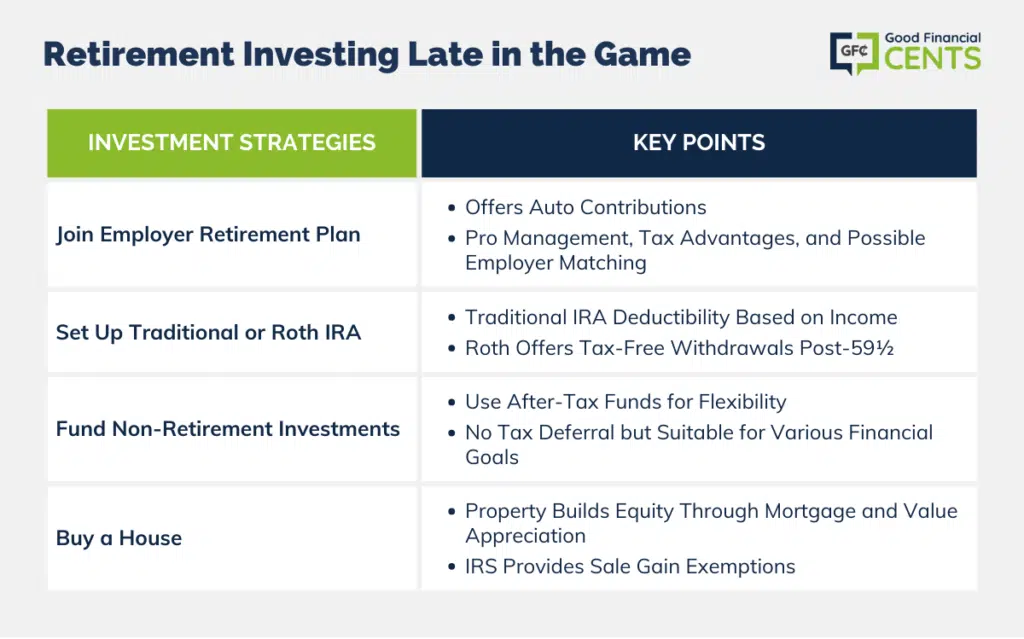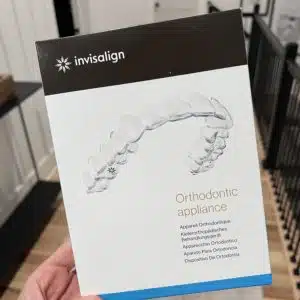A lot of people are slowly moving into middle age, only to realize that they have very little in the way of savings and investments. There are a lot of reasons why it happens, like student loan debt, the tough job market, and even extended adolescence. But at just about any age you can play catch-up with investing. Check out our review on Motif Investing for more info! This topic was motivated by an Ask GFC question submitted by Kate C.: What’s the best way to “catch up” if I didn’t start investing early enough? I’m in my mid-30s and still have some time but I’m still not where I know I should be. Thanks Jeff! 🙂 Frankly, this is the question I wish more people would ask. There’s no crime in not having invested money up to this point, but just asking the question opens up the chance to change direction. How do you go about that?
Always Look Forward, Never Back
Take everything that you’ve done in the past – including your inaction – and throw it out the window. It didn’t help you in the past, and it won’t help you now. Instead, focus on the future that you want to create. One of my favorite quotes is from Dan Sullivan who says, Always Make Your Future Bigger Than Your Past. Once you have a good handle on that, it becomes easier to set the financial goals that will enable that future to happen.
And once you set the goals, you can establish an action plan. That plan should focus on what you are going to do, and you’re not going to ruminate on the past. Reaching any level of financial independence requires a commitment to the future, and to the processes that will get you there. Once you’ve got that set your mind, you can work on a plan for how to make it happen. Let’s talk about that plan.
Join Your Employer Retirement Plan and Max Out Your Contributions
For most people, the easiest way to invest by far is through an employer-sponsored retirement plan. Participating in one gives you the advantages of:
- Automatic Contributions, Payroll Deducted So You Won’t Even Know It’s Happening
- Automatic Investing in Pre-determined Asset Allocations
- Professional Management – You Don’t Have to Do the Work
- Tax Deductibility of Contributions, and the Ability to Ignore the Tax Consequences of Your Investment Activity
- The Possibility of an Employer Matching Contribution, if They Provide One
There are too many advantages to this plan to ignore. If you haven’t participated in the past, enroll in the plan immediately. You can contribute up to $23,000 per year, or $30,500 if you are 50 or older. That kind of savings can supercharge your investing in a hurry. It may even be the simplest way to do it.
Set Up a Traditional or Roth IRA
If you don’t have an employer-sponsored retirement plan at work, you should set up an IRA. This will enable you to save up to $7,000 per year, or $8,000 per year if you are 50 or older.
Traditional IRA.
The contributions to this plan are fully tax-deductible if you are not covered by an employer plan. If you are, there are income limits on the amount of the contribution that will be tax-deductible. For example, if you are single, and covered by an employer plan, you can still make a tax-deductible contribution if your income is less than $77,000. You can make a partial contribution between $77,000 and $87,000. Beyond $87,000, the IRA contribution will not be tax deductible.
If you’re married filing jointly and covered by an employer plan, your IRA contribution will be fully deductible if your income is less than $123,000. You’ll receive a partial deduction if your income is between $123,000 and $143,000. If you are the contributor and do not have an employer-sponsored retirement plan but your spouse does, your deductibility will be based on an income of $230,000 to $240,000.
However, you can make a contribution to an IRA even if you are covered by your employer, and your income exceeds the limits. The contributions won’t be tax-deductible, but the investment earnings on those contributions will be tax-deferred. That means they will not be taxable until you begin making withdrawals in retirement. If you make withdrawals prior to turning age 59 1/2, you’ll have to pay a 10% early withdrawal penalty, in addition to regular income tax.
Roth IRA.
Roth IRAs are similar to traditional IRAs, except the contributions are not tax-deductible, and withdrawals will be tax-free as long as you are at least 59 1/2 years old, and have participated in the plan for at least five years. You can contribute to a Roth IRA even if you are covered by an employer-sponsored retirement plan. Much like traditional IRAs, your investment earnings accumulate on a tax-deferred basis.
The investment earnings (but not your contributions) will be taxable if you withdraw them before age 59 1/2, as well as subject to a 10% early withdrawal penalty. There are income limits to Roth IRAs too, but they don’t refer to tax-deductibility (since Roth IRA contributions aren’t tax-deductible anyway). The income limits on Roth IRAs mean that you cannot make a contribution to the plan at all if your income exceeds certain limits.
The 2023 limits have changed from last year. If you are single, you can make a full Roth IRA contribution with an income of up to $146,000. Between $146,000 and $161,000, you can make a partial contribution. Beyond $161,000, a Roth IRA contribution is not permitted. If you’re married filing jointly, you can make a full Roth IRA contribution with an income of up to $230,000. Between $230,000 and $240,000, you can make a partial contribution. Beyond $240,000 a Roth IRA contribution is not permitted.
Once again, those income figures are for 2025. Whether used for a standalone retirement plan, or as a supplement to an employer-sponsored plan, an IRA is an excellent way to add additional savings and expanded investment opportunities to enable you to catch up if you’re behind in your investing activities. For example, if you can save $23,000 in your 401(k) plan, plus $7,000 in an IRA, you can save $29,000 per year. That would make up for a lot of lost time quickly.
Fund Non-Retirement Investments
Not all of your money can or should be invested in retirement plans. You can also save money in non-tax-sheltered savings vehicles, such as an investment brokerage account, mutual funds, or exchange traded funds. There is no tax deduction for saving money this way, nor is there any tax deferral. However, since these investment vehicles are funded out of after-tax income, and taxes are paid on investment earnings as they occur, you can pull money out of these vehicles anytime you want, without having to worry about creating an income tax liability.
They are also excellent savings vehicles for intermediate investing goals, such as saving money to buy a house, or preparing for your children’s college education. Betterment Investing is a great option here because they do a great job with ETFs and avoiding lots of fees and taxes. And perhaps best of all, there’s no limit on how much money you can save and invest with these vehicles.
Buy a House
You’ve got to live somewhere, right? Buying a house is a way to both provide yourself with shelter, as well as make an investment for the future. A house can accumulate net worth from two directions. The first is through amortization of the mortgage loan. The loan principal is paid down a little bit each year, until the end of the term when it is paid off completely. As it does, your equity in the house grows. But since a house is also a type of commodity, it tends to rise in value roughly consistent with the level of inflation over the long-term.
That gives you the benefit of a higher market value. As an example, let’s say you buy house today for $250,000, using a $200,000 thirty-year mortgage, and a $50,000 down payment. The house is worth $250,000, so your equity is only $50,000. After 30 years, the mortgage is paid down to zero. During that same timeframe, the value of the property doubles to $500,000. You now have $500,000 equity in the house, that started with just 50,000. You can then either live in it mortgage free, or you can sell it and cash out your equity.
If you do, the IRS provides a generous exemption on the gain on sale of your primary residence of up to $250,000 if you’re single, and up to $500,000 if you’re married filing jointly. If property values continue to rise consistently, and you can resist the trend to borrow your equity out prematurely, the house can be one of the best ways to fast-forward your investing. If you think that you’re behind in your investing, and that you need to play catch-up, plan to set up your investing activity in various areas of your life. Each can contribute to a dramatic increase in the amount of investments that you have, even if you don’t have much invested right now.

The Bottom Line – Ask GFC 001: Playing Catch Up – Retirement Investing Late in the Game
When catching up on retirement investing, focus on the future, not the past. Set big goals and commit to them. Join your employer’s retirement plan and maximize contributions. Consider setting up a Traditional or Roth IRA for additional savings. Invest in non-retirement vehicles like brokerage accounts or ETFs. Owning a house can build equity over time. Establish a multi-faceted investment approach to make up for lost time and secure your financial future.








Does it make sense to contribute to a traditional IRA after maxing out on 401k x2 (36k) for high income dual income earners (200k annually married filing jointly) if there is no tax deduction? Or backdoor Roth would be the way to go?
Either’s not a bad strategy, since it will give you at least some tax-free income to withdraw at retirement. I would generally recommend the backdoor Roth IRA, but at your income level, the immediate tax bite would be big. You have to evaluate if you want to deal with that now.
Thanks for the response! Really love your stuff.
Great post! So many Gen X and Gen Y friends have the mindset that they haven’t started saving, so why bother? Makes me want to pull my hair out 🙂 Gotta start somewhere/sometime!
That’s awesome about ask GFC! Heading over there to ask a question about planning for retirement from a tax perspective. Great article here too btw. It’s too bad when people think it’s “too late”, get discouraged, and then continue to put it off because they think they’ve already missed out. As you said, it’s never too late.
The biggest mistake I see my friends make is that they don’t invest in their employer-sponsored plan! It’s the easiest and safest in my opinion, especially for the very inexperienced investor.
The reason why I don’t invest with my employer is, so many of my co-workers that have retired from the company has lost so much money due to the economy. This is a scary feeling to see alot of your earnings diminished.
Roderick, if you’re investing for the long-term and are appropriately diversified, dips in the stock market or economy won’t matter. Historically, the stock market always comes back stronger than before it tanked–each and every time. It takes patience (investing for the long-term) and not selling out of panic or emotion. When you’re getting close to retirement, you need to own your retirement and make sure you’re invested conservatively enough for your life stage (work with an advisor if you need assistance with this). If there’s a match with your employer plan, start contributing so you can take advantage of that free money.